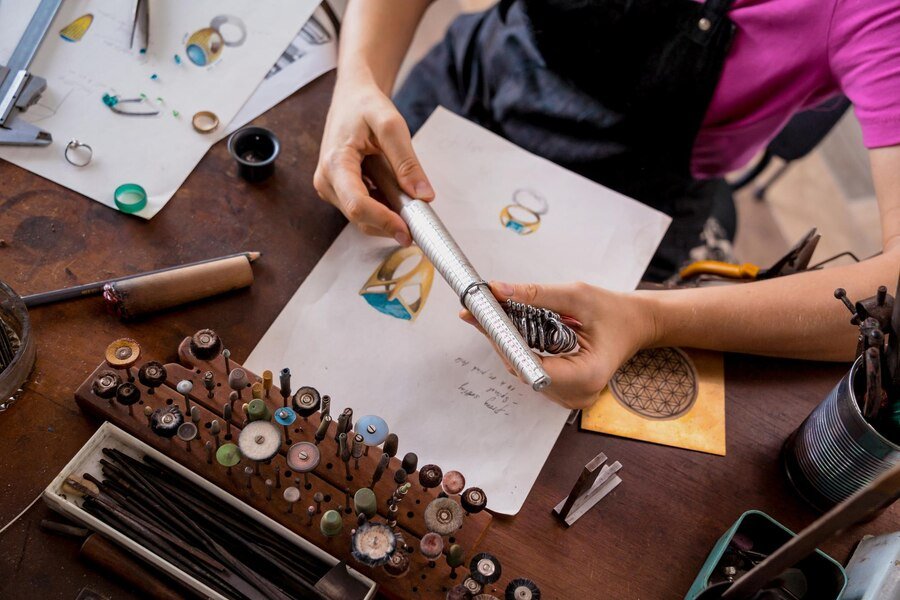
Jewelry has always been more than just an accessory. Across centuries and cultures, it has served as a form of expression, a status symbol, and a reflection of personal and collective identity. Today, the jewelry industry is evolving at the intersection of art, design, and craftsmanship, where creativity meets technical precision to produce wearable masterpieces.
From avant-garde statement pieces to minimalistic, thoughtfully designed collections, jewelry has become a bridge between artistic expression and functional design. Leading brands like Alexis Gallery embrace this philosophy, creating custom, handcrafted pieces that seamlessly blend artistry with impeccable craftsmanship.
Let’s explore how these worlds collide to shape the future of contemporary jewelry.
1. Jewelry as an Art Form
At its core, jewelry is a form of artistic expression. Just as a painter uses a canvas or a sculptor molds clay, jewelers transform raw materials—gold, silver, gemstones—into intricate, meaningful designs. Many designers today are blurring the lines between fine art and jewelry, pushing creative boundaries by incorporating unconventional materials, abstract concepts, and even storytelling elements into their work.
Artistic jewelry often moves beyond aesthetics to explore deeper themes—identity, culture, and even social or political narratives. Contemporary designers are redefining jewelry as an immersive, conceptual experience, rather than just an ornamental addition to an outfit.
2. The Role of Design: Balancing Function and Aesthetic
While jewelry is undoubtedly an art form, it must also be wearable. This is where design plays a crucial role. A well-designed piece balances beauty with ergonomics, durability, and comfort—all while maintaining its artistic integrity.
Modern jewelry design incorporates cutting-edge technology like CAD (Computer-Aided Design) modeling, 3D printing, and advanced metalworking techniques, allowing designers to push creative limits while ensuring structural integrity.
Jewelry must also reflect the wearer’s lifestyle and values. Whether it’s an everyday minimalist ring or a bold, sculptural necklace, good design ensures that the piece is not only visually striking but also practical and enduring.
3. The Influence of Architecture and Sculpture in Jewelry
There is a strong architectural and sculptural influence in contemporary jewelry design. Many jewelers take inspiration from geometric structures, natural forms, and industrial aesthetics, resulting in pieces that resemble miniature works of architecture or abstract sculptures.
Elements like negative space, asymmetry, and modularity are increasingly being used to create bold, innovative designs. Some jewelers even collaborate with architects and sculptors to bring their artistic vision to life, reinforcing the connection between jewelry and larger artistic disciplines.
4. The Handmade vs. Digital Debate in Jewelry Making
The tension between traditional craftsmanship and digital innovation is shaping the modern jewelry landscape. Handmade jewelry, with its artisanal touch, continues to be highly valued for its uniqueness and meticulous craftsmanship. On the other hand, digital tools like 3D printing and AI-assisted design are opening up new possibilities for precision and customization.
Rather than replacing traditional techniques, digital advancements are enhancing the jewelry-making process, allowing artists to experiment with intricate designs that would be nearly impossible to create by hand alone. The best contemporary jewelry brands seamlessly integrate both approaches, combining artistry with technological precision.
5. Jewelry as a Medium for Storytelling
One of the most compelling aspects of jewelry is its ability to tell a story. Whether through symbolism, personal engravings, or repurposed heirloom materials, jewelry carries emotional weight. Many designers craft collections that weave together history, cultural heritage, and personal narratives, making each piece more than just an object—it becomes an experience.
This storytelling aspect is why custom jewelry is gaining traction. Personalized and bespoke pieces allow wearers to carry a part of their story with them, whether through initials, meaningful gemstones, or custom engravings.
Final Thoughts
Jewelry exists at a fascinating intersection—where artistic creativity meets functional design, where traditional craftsmanship meets modern technology, and where aesthetic beauty meets personal storytelling. As artists and designers continue to push the boundaries of what jewelry can be, the industry is evolving into an even more dynamic and expressive space.
The future of jewelry lies in its ability to merge art, innovation, and emotional connection, proving that it is far more than just decoration—it is a wearable reflection of creativity and meaning.
